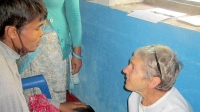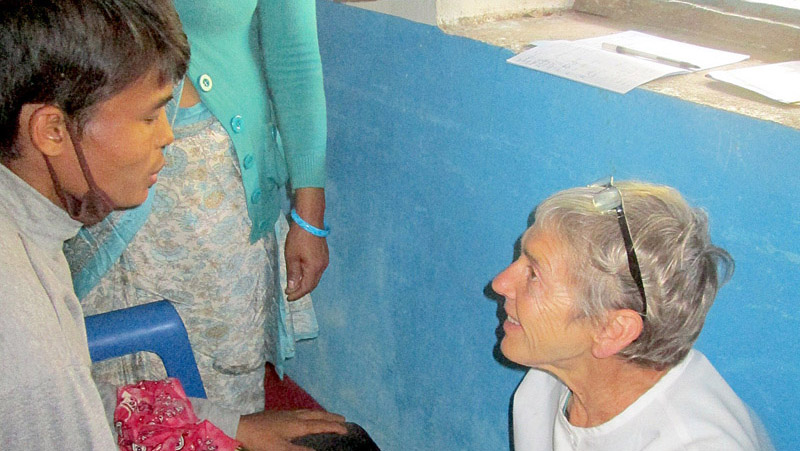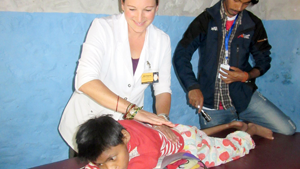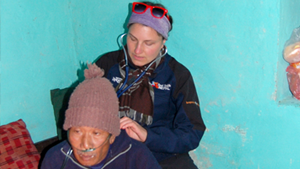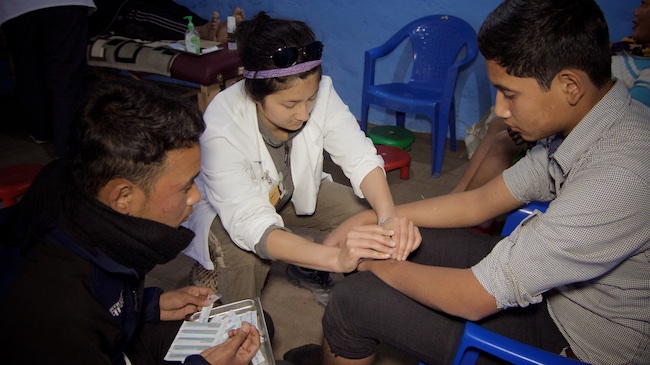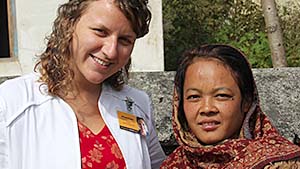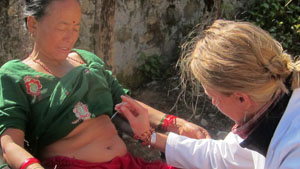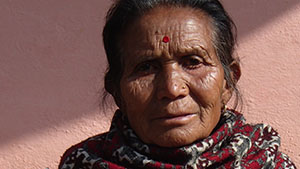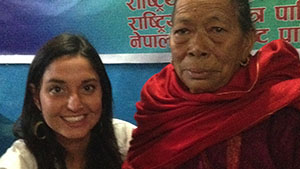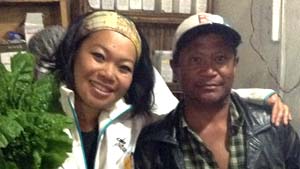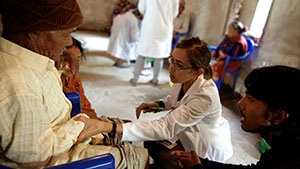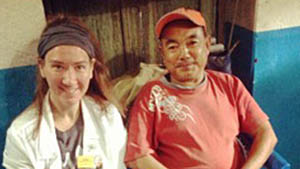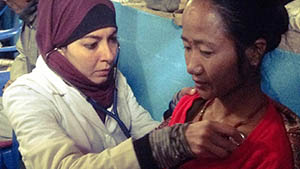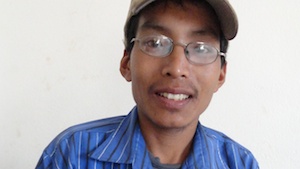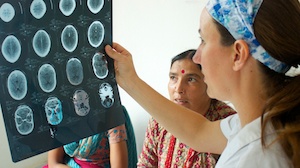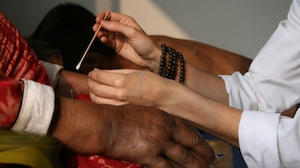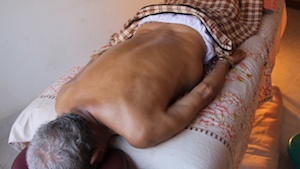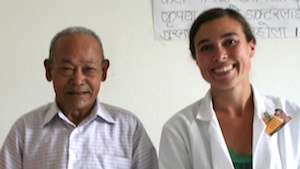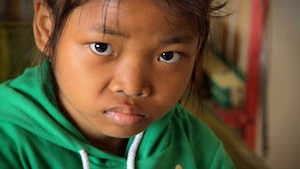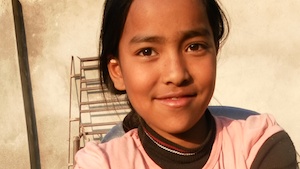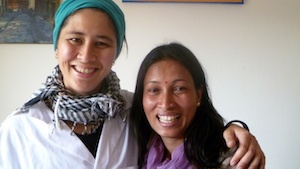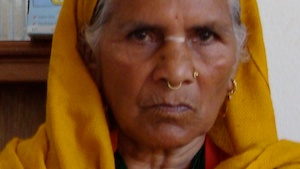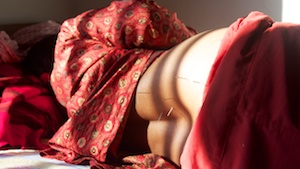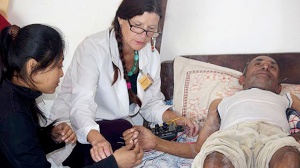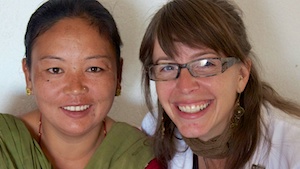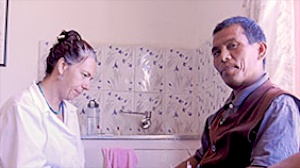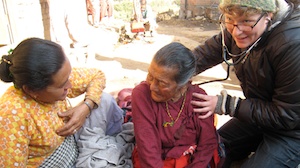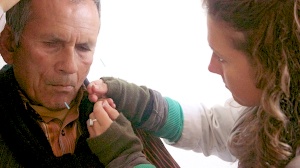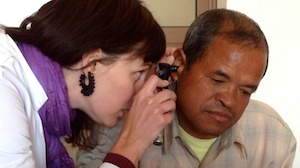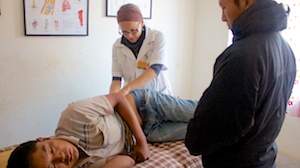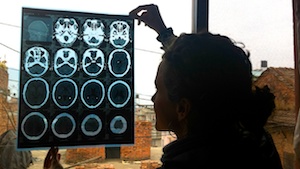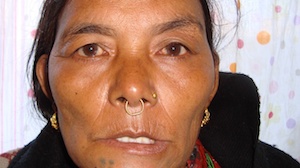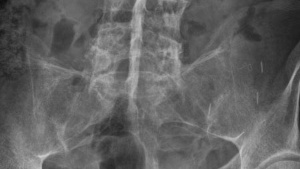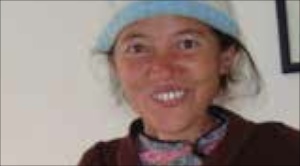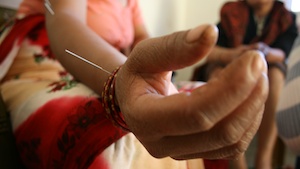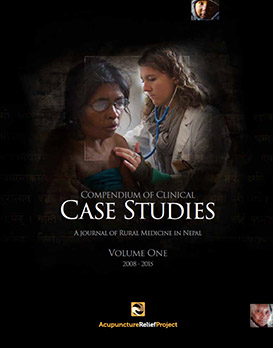Patty McDuffey, LAc, MAcOM, Dipl OM
November 2013
OVERVIEW
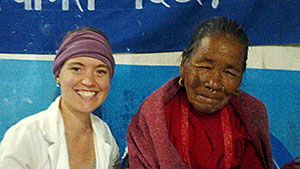
70-year-old female patient presents with urgent, frequent diarrhea. No enteropathogenic organisms are present, however blood is found in the stool. Allopathic care has been unable to resolve her symptoms. After 17 acupuncture treatments and the use of Chinese herbal medicine, the patient has experienced 75% reduction in symptoms since the initial onset 14 weeks ago.
Subjective
70-year-old female patient presents with urgent diarrhea with initial onset 2 months prior to 1st visit. She suffers from frequent, watery diarrhea 12 times per day that occurs upon waking in the morning, after eating, and throughout the night. Mucus and undigested food are present in the stool. The stool is reported to be red, black, yellow and white in color with a strong odor. Patient was admitted twice to the Chitwan Medical College Teaching Hospital in Chitwan, Nepal and reports no change in symptoms with allopathic medicine, nor does the patient understand the cause. Patient's appetite is poor with little water intake (2-3 glasses per day), and a subjective sinking sensation. She does not have a fever, nor does she experience abdominal pain, but does report feeling cold. Previous to the onset of diarrhea, she reports having a history of normal bowel movements.
OBJECTIVE
Patient is very soft-spoken, but alert with full mental capacity. She has a gentle, optimistic spirit and appears to be in relatively good health for her age and environment.
Hospital lab tests run at Chitwan Medical College Teaching Hospital 15 days after initial onset of symptoms show an initial diagnosis of dysentery. Complete Blood Count (CBC) shows Eosiniphil Sedementation Rate (ESR) value of 46 Mm/Hr (normal range 0-20). Urinalysis indicates urine pH 5.0 (slightly acidic), potassium level of 2.58 Mmol/l (normal range 3.5-5.5) and urea 14 mg/dl (normal range 20-40). Stool culture shows a RBC (Red Blood Cell) count of 2-4, indicating blood is present in the stool, a pus count of 6-8 with mucus present on physical examination, and no enteropathogenic organisms after 48 hours of incubation. No pain on abdominal palpation, nor abdominal masses, are found. Slight gurgling is detected in the lower left quadrant of the abdomen on palpation. Hands and feet are cold to the touch.
While at the hospital, the patient was given the following medications at an unknown dosage and duration:
Cifran: Ciproflaxacin - broad-specturm antimicrobial
Metron: Metronidazole - antibacterial and antiprotozoal
Ondem: Serotonin type 3 receptor antagonist, typically used for nausea/vomiting associated with cancer and post-operative treatment
Pantop: Proton-pump inhibitor for gastroesophageal reflux disease (GERD)
Bifilac: Probiotic
Dometic: Domperidone - antiemetic
Codophos: It is not clear which medication was administered; either Odophos, which is an iron mineral supplement, or Colophos, which is a laxative.
Potclor: Potassium electrolyte supplement
Enterogermina: Probiotic/anti-diarrheal
Doxobid: Doxofylline - anti-asthmatic
Upon discharge from hospital, the patient was administered the following meds:
Dometic 10mg PO TID (3 days)
Pantocid 40mg PO BID (10 days)
Codophos 15mg PO TID (2 days)
Enterogermina 1 Tab PO QD (7 days)
Potclor 15ml PO TID (5 days)
Doxobid 400mg PO BID (10 days)
Cifran 500mg PO BID (5 days)
Metron 400mg PO TID (5 days)
Seroflo 250mcg PO BID (continuous); Fluticasone Propionate is a corticosteroid used for asthma. The patient has a history of asthma.
Pulse is slippery, and the tongue is red and moist with a thin, white coat.
ASSESSMENT
DX: Ulcerative colitis
Differential DX: Colorectal cancer; Diverticular bleeding
Due to the presence of pus and blood in the stool, another diagnosis could be colorectal cancer. This diagnosis seems less likely because the abdominal scan is negative for masses, nor is occult blood present in the stool. Another possibility is diverticular bleeding.
This is more likely than colorectal cancer as diverticular bleeding becomes more common with age. However, it often causes major bleeding, which is not present in this case. Ulcerative colitis is the most likely culprit, with frequent bloody diarrhea being the primary symptom. Systemic symptoms are often absent or mild. It can also be aggravated by NSAID's.
TCM DX: Primary - Spleen and Kidney yang deficiency with sinking Spleen qi; Damp-heat present in the Stomach and Large Intestine
PROGNOSIS: Good recovery is expected due to her overall good health and relatively short duration of symptoms.
INITIAL PLAN
Electrolyte salt pack is administered on first visit for rehydration.
Acupuncture and moxibustion 3 times per week for 3 weeks before reevaluation. Focus on lifting Spleen qi, nourishing the Spleen and the Kidney and clearing damp-heat from the intestines. Use of moxa is intended to replenish pure yang energy in the Kidneys. Herbal treatment of Bu Zhong Yi Qi Tang 2 pills TID to nourish and lift Spleen qi. Diet recommendations include the elimination of dairy and the inclusion of more high fiber foods such as fruits and vegetables, meat and warming (aromatic) foods to address nutritional deficiency. Increase liquids to at least 1 liter water per day. If symptoms do not continue to improve over the 1st course of treatment, further lab tests will be ordered.
Typical treatment: ST36, ST25, CV12, CV6 and LI 0 with 1" deep needle insertion
Alternate treatment: SP3, SP4, DU20, LI4, SP15 and ST37
Treatments include abdominal indirect moxa at the periumbilical region near ST25, SP15, CV12 and CV6. Particular emphasis is placed on the herbal formula as patient needs to receive daily care and nourishment to fully recover.
OUTCOM
After the 3rd treatment, little change was seen with Bu Zhong Yi Qi Tang, so the formula was changed to Fu Zi Li Zhong Wan (8-10 pills, TID) alternating with Li Zhong Wan (3 pills, BID). More emphasis was placed on tonification of the Kidney yang energy. At the 6th treatment, the patient reported that the stools were more soft than watery. Mucus and undigested food in the stool were still present.
At the reevaluation (9th visit), the patient was having 7-9 bowel movements per 24-hour period, approximately a 40% improvement from the initial visit. Her appetite was better and she was eating a wider variety of foods 3 times per day. Though mucus was no longer seen in the stools, there was still a strong odor and the patient continued to experience urgency to use the toilet. A high fiber, low fat diet was recommended. At this treatment, the patient reported feeling dizzy since the initial onset of symptoms 3 months ago.
The patient took a minor fall sometime in the days after the 9th treatment, injuring her left medial knee joint. As a result, ibuprofen was administered to decrease inflammation. An increase in bowel movements to 10-11 per day coincided with the administration of ibuprofen, suggesting that the NSAIDs were irritating the mucosal membranes.
After cessation of the ibuprofen (13th visit) the patient reported only 3-4 bowel movements per 24-hour period for the previous 4 days. However, she still experienced days with as many as 8 bowel movements. Stools still alternated between soft and watery with strong odor and yellow in color, but were not always urgent.
Ten weeks (15th visit) after initial acupuncture treatment began, an herbal formula was added to further help clear heat from the intestines: Qing Wei San 6 pills TID. Fu Zi Li Zhong Wan was reduced to 6 pills TID. After the addition of Qing Wei San, the patient's stools reduced to 3-4 per day with a formed consistency. At this time, a follow-up stool analysis and CBC was ordered. Pus cells were no longer found in the stool with the RBC count in the stool reduced to 0-1 HPF.
Treatment plan was modified to continue with 1 acupuncture and herbal treatment once per week for 2 additional weeks before requesting another stool analysis and CBC. If blood is still present in the stool or if symptoms return, a colonoscopy will be ordered to determine further course of action.
CONCLUSION
Over the course of treatment, the patient experienced significant improvement in symptoms and arrived for each appointment optimistic about her progress. Due to her age, recognizing the role and good health of the Kidneys in her treatment prognosis is critical to her well-being. 2 critical points in the treatment plan were the switch from focusing on the Spleen to focusing on the health of the Kidney yang energy and the addition of the heat clearing formula to stop bleeding in the intestines. When little results had been achieved from the formula, Bu Zhong Yi Qi Tang, the treatment approach was changed to more strongly nourish the Kidneys. The formula was switched to a Kidney-based formula in the Li Zhong Wan family. When the stool analysis showed that there was still blood present in the stool, Qing Wei San was added to help cool the gastrointestinal tract and stop bleeding. Diarrhea can be an especially dangerous symptom for the elderly. With acupuncture, Chinese herbs, supportive care and allopathic testing, I am optimistic that the patient’s health will continue to improve. A colonoscopy would confirm the diagnosis of ulcerative colitis at which point a more accurate management plan and prognosis could be made. At this point in her progression, I expect that the patient will need to continue care at the clinic for an additional month, focusing on herbal and dietary therapy to resolve her condition. As a member of the elderly community in a small, rural village in Nepal, the improvement in my patient's health is a significant contributing factor to the health, well-being and sustainability of her community.


